Russian heating system & hot water supply market
- 6,249 views
- 0 comments
Boiler units output in Russia has practically halved since the end of 80-s. Many people are inclined to explain this by domination of imported equipment. But even a fleeting glance at Figure 1 presenting the Russian boiler units market structure denies this opinion. It looks like the key reason of the fall in domestic output was a general decrease in demand caused by economic difficulties. However, from 1997 domestic manufacturers started increasing their production volumes. Nowadays, we witness an increased demand for domestic AOGV boilers made by ROSTOVGAZAPPARAT and the Zhukovsk Engineering Plant. The Bryansk Engineering Plant, Konord/Rostsel’mash and the Cheboksary Research Plant have increased the output of KSTG boilers. Thus, imported equipment did not have any negative influence on domestic boilers sales. On the contrary, the availability of expensive advanced foreign equipment forced domestic producers to improve both appearance and quality of their output goods.
Nowadays, domestic producers control up to 95% of the Russian low and average power boilers market (see Figure 1).
FIGURE 1

However, it is worth noting that from 40 to 90% of boilers are sold through barter. That is why Russian producers do not see reasons to invest much money in advertising. As a result these are mainly foreign boilers that enjoy popularity among mass consumers especially in Moscow. Here we have to say that the bulk of imported boilers are consumed by Moscow and its suburbs, as well as partially by other big cities. It is Korean equipment, first of all, Saturn that takes the biggest share of foreign boilers sold the other side of Ural. At the same time two brands – ACV (Belgium) and Protherm (Czechia) are in the greatest demand in the European part of Russia. In general, inexpensive but qualitative equipment from the nations of Eastern Europe superseded Italian and German products for the last two-three years. Nowadays, only three Czech companies – Protherm, Modratherm and Dakon account for 30% of imported products (see Figure 2)
The fact that many plants of Eastern Europe switched from making the license and joint products to developing own equipment is a good example for Russian businesses.
FIGURE 2

Though, a number of domestic plants started developing joint perspective programs with western companies. So the famous Krasnyjj Kotel’shhik Plant in the city of Taganrog makes boilers of German design in cooperation with Stan Muller. The biggest Russian producer of wall gas boilers – ZAPSIBGAZPROM collaborates with Ferroli Co.
The Kazansk Gas Equipment Plant launched a joint production with the German Company Dessauer – Gassroger. Ziosab company established on the basis of the Podolsk Engineering Plant sells its products through the Russian-Finnish joint venture. The Moscow enterprise Stavan-M uses foreign burners and automated mechanisms (Lamborghini and Oilon) in its production. This plant’s products sell not only in Russia but also in Uzbekistan and Mongolia.
So one can say for sure that domestic producers managed to cope with the hard times and have a good chance to reinforce their market positions with the heating systems decentralization.
Hot-water heating units
Hot-water heaters market situation resembles that one of boiler units market. Foreign equipment covers only 6% of total demand. The Minsky plant making cast-iron radiators МC-140 known as "battery" takes other 19%. And, finally, domestic products take ¾ of the whole market (see Figure 3).
FIGURE 3

Though, the total number of hot-water heating units made in Russia has significantly decreased, their quality has improved. The most advanced domestic businesses offer competitive products today already. First of all, these are the Santekhprom Public JSC Ltd. famous for Universal-TB convectors, the Stupino Metallurgical Plant making aluminum tube heaters PC and the Izotherm JSC located in the town of Kolpino making the same equipment. In addition, Izotherm Co. plans to master the manufacture of steel panel heaters in the near future. And the Santekhprom Co. plans to introduce many sections steel tube heaters known as tube heaters. There are also other domestic manufacturers.
As to foreign equipment these are two types of radiators, which manufacture is at the early stage of its development in Russia – aluminum many sections radiators and steel radiators of panel type. Most part of aluminum radiators is presented by three Italian brands – Fondital, Industrie Pasotti and Global. This equipment is constructed to work with high operating pressure and adapted to Russian heat networks. That is why it is very popular.
The Czech Korado company and the Slovak Korad company are the leaders among producers of panel type steel radiators. These companies’ equipment is adapted to Russian heat networks according to recommendations of the Sanitary Engineering Research Institute (see Figure 4)
FIGURE 4
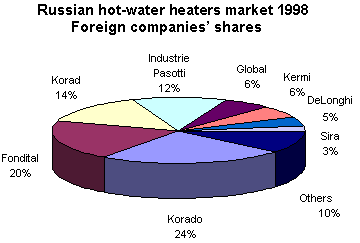
Water Heaters
The manufacture of gas instantaneous water-heaters well-known as "kolonka" in the Soviet times was gradually decreasing up to 1998. However, they still take the dominating position on this market segment. A number of water heaters produced by the Armavir plant only exceeds the total number of this equipment supplied from abroad. Owing to low prices domestic equipment is still in demand in regions. In Moscow and S-Petersbourg, however, foreign equipment takes the largest share. The price of the best Russian water-heaters Proton-3 made by the TULCHERMET plant had been higher that one of foreign analogue equipment until recently. That is why they were not in great demand.
The situation was changed by the crisis of 1998 when the retail price of Proton-3 decreased from 300$ to $100. Nowadays these modern water-heaters with a gas unit analogue to popular Czech equipment – Mora have pressed even foreign products.
As to electrical instantaneous water-heaters Russia started making this equipment not long ago. Meanwhile, they are behind foreign equipment by design and practically unknown to mass consumers.
At the same time having plain design but being well-promoted Atmor equipment is an undoubted sale leader (see Figure 6).
FIGURE 5
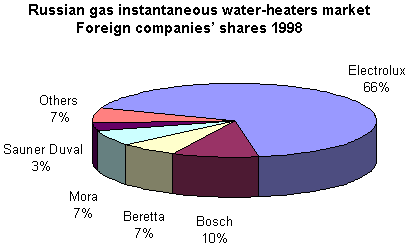
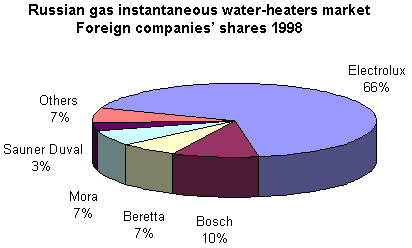
FIGURE 6
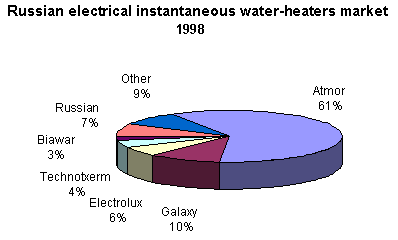
Atmor’s leading position can be easily explained by the fact that its price is 2-2,5 times lower as compared to that one of any other foreign instantaneous water-heater.
As to accumulating water heaters market, here the leading position is also taken by inexpensive equipment – Ariston. (see Figure 7). At the same time the total share of expensive equipment – Electrolux, Tatramat and Austria Email is 50%.
FIGURE 7
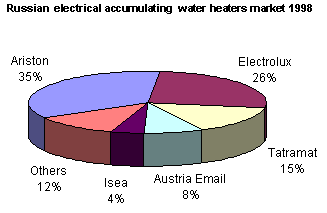
High share of expensive equipment can be contributed to the fact that unlike instantaneous water-heaters that are mostly used in the city in summer when hot water supply is cut off accumulating water-heaters are often used in cottages and dachas not only in summer but also in winter. That is why they want to be sure in equipment reliability.
Polymeric tubes
The Soviet Union started making polymeric tubes as long ago as early 60-s. However, plastic tubes did not go into mass production because of high popularity of metal products at those times. By the moment of the Soviet Union disintegration these were four businesses where the manufacture of polymeric tubes and raw materials was concentrated – the Kazan’orgsintez Plant, the Tomsk Chemicals Plant, the Budennovsk Chemicals Plant, the Moscow Plastic Scientific and Production Company and the Kubra Plant located in the town of Syzran’.
Some times later the list of polymeric tubes manufacturers was added by the Stroypolimer Scientific and Production Company, the Genta Plant and the Teploimport Plant located in the city of Moscow. It looks like domestic producers went through the temporary decrease in demand caused by the financial crisis of 1998 and now reinforce their market positions owing to reduction in domestic raw materials prices and men power costs. Nowadays Russian polypropylene and even plastic-and-metal tubes are cheaper that ones made in Turkey. That is why in 1999 already one can expect a sudden growth in domestic companies’ shares on this market (see Figure 8).
FIGURE 8
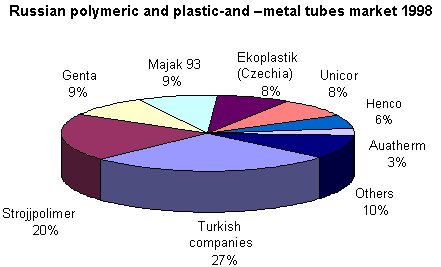
This year launch of new works making polymeric and plastic-and-metal tubes in the cities of S-Petersbourg (the Liral’ plant) and Saratov is evidence of good prospects of this market segment.
